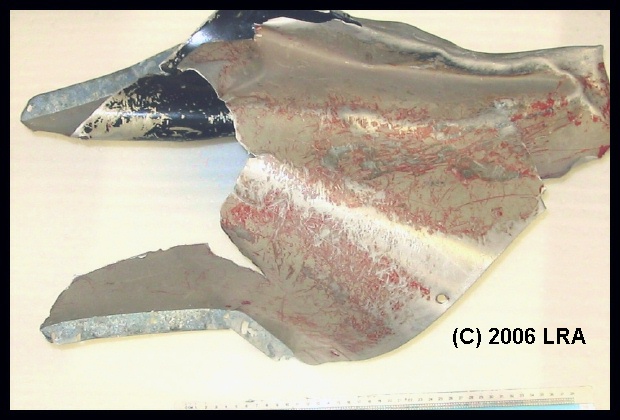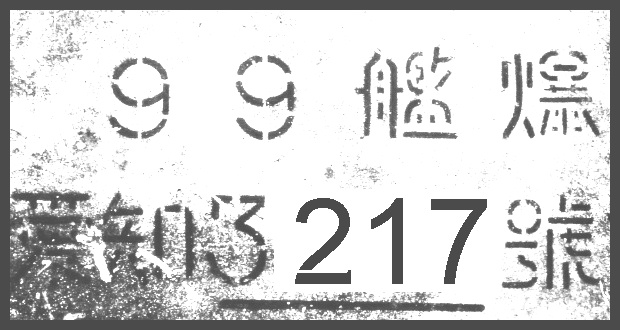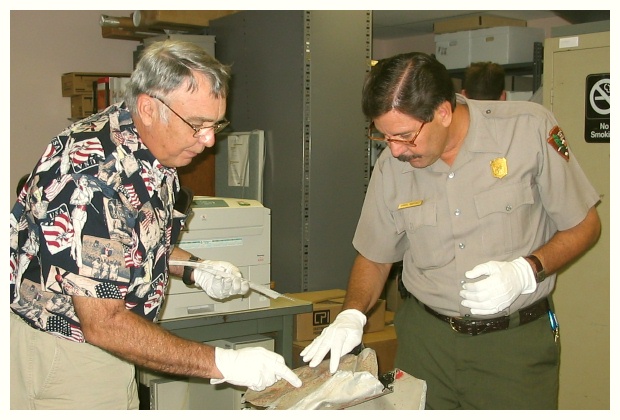by James Lansdale
Aichi Kanbaku Relic USAR 1021
In September 1992, Hurricane INIKI struck the Hawaiian Islands of
O’ahu
and Kaua’i. On O’ahu, the leeward shoreline from Kaena and
Makaha Point to Barbers Point was affected by high winds, pounding surf,
and a great deal of beach erosion. Left exposed on the beach by Hurricane
INIKI was a 48cm piece of twisted and torn aluminum metal, later identified
as having come from an Aichi Type 99 Carrier Dive Bomber (Kanbaku) shot
down during the attack on Pearl Harbor, 7 December 1941. Subsequent to
its having been found, the Aichi Kanbaku artifact was donated to the ARIZONA
Memorial (AM) and recorded as article “USAR 1021” and placed
into storage in building No.416. USAR 1021 was found on the beach
in the area described in the wartime reports of aerial engagements by USAAC
2nd Lt. Kenneth M. TAYLOR* and 2nd Lt. George S. WELCH.** As a result,
this Kanbaku artifact is associated with one of their victories that day
over Barbers Point. AKAGI Kanbaku pilot IIZUKA, Tokuji also recalled this
battle in his original memoirs translated by Dr. KAWAMOTO, Minoru.***
On the morning of 13 December 2006, Kanbaku artifact USAR 1021 was examined and photographed in detail by Daniel MARTINEZ, ARIZONA Memorial Historian; Scott PAWLOWSKI, ARIZONA Memorial Curator; and James F. LANSDALE. The following characteristics were recorded during this examination.

Artifact USAR 1021 was twisted, bent and torn as a result of a high-speed impact with the ground. There was no evidence of any marine growth, however, the external surfaces (shown above) had been subjected to severe weathering, paint dulling, and blanching due to the effects of salt-spray and/or strong tropical sunlight. On one side, the external surface and paint layers had been abraded by contact with the sand as the piece had been moved up and down the beach due to wave action. On the interior surfaces, the folds in the metal had protected the paint from weathering and blanching and the paint was found to be glossy and almost mint! This protection from the elements, as shown by the condition of the interior surfaces, probably indicates that this piece was buried under the drifting dry dunes of the beach for long periods of time.

The interior surface colors (shown above) include both aotake (translucent green) and gloss black overspray. The gloss black paint sprayed on the interior surfaces of Aichi aircraft products is frequently encountered. The layer of black paint had been applied over the Aichi aircraft identification stencil. However, the raised surfaces of the stencil itself showed through and could still be read, but not without some difficulty. The identifying markings in Arabic numerals and Kanji read:
AI CHI 3217 GO
(Type 99 Carrier Bomber, Aichi S/N 3217)
This Kanbaku was less than six months old when brought down, having been one of eighteen produced by Aichi in June 1941 as estimated by James I. LONG. Since it was almost impossible to photograph the entire Aichi stencil due to the folds in the metal as well as the use of black paint sprayed over the original black stenciling, a facsimile of these markings as it appeared is provided here below.

As described earlier, the external surfaces were weathered, pale in color, and with little gloss. Interestingly, where the surfaces of the relic had been abraded by the sandpapering action on its contact surface, several layers of paint were revealed stratified down to the bright and shiny aluminum.
Artifact USAR 1021 was taken to a natural light setting and the external colors visually compared to the JPMA Standard Paint Colors 2005-C color chips. The outermost surface paint was extremely pale and chalky, characteristic of severe weathering. The outer surface external colors varied in different locations from a flat and chalky JPMA C25-70B (Munsell 5Y 7/1) to a darker JPMA C25-60D (Munsell 5Y 6/2). These colors are close to variations of Federal Color Standards 595B FS-16350. Within some of the exterior folds the color appeared to be close to JPMA C22-60D (Munsell 2.5Y 6/2).


There were unexpected findings!

Daniel MARTINEZ (shown above on the right examining USAR 1021) discovered an area where damage to the metal and paint revealed what appears to be an anodized metallic surface (a metallic gray) applied to the aluminum. It has yet to be determined if this is an aberration due to crash damage or if this had been applied to the external sheet metal prior to the assembly of the aircraft. The second finding was that the outermost layer of paint had been applied over a layer of bright, hinomaru red paint, close to JPMA C05-40V (Munsell 5R 4/12), not a red-oxide primer! Dan MARTINEZ also stated that this coincided with an earlier identification that the USAR 1021 relic had been from the leading edge of an Aichi Kanbaku fin. If this is so, the sanding action in the surf has revealed that this Kanbaku was one of the early “red tailed” Kanbaku with an original prewar livery prior to repainting before the attack on Pearl Harbor.
Jim Lansdale
Credit: Daniel Martinez (AM Historian), Scott Pawlowski (AM Curator), James I. Long, and LRA. Barbers Point area map provided by http://www.inoahu.com
*Supplement A:
Excerpted from "Damned to Glory" by Col.Robert L. Scott, Jr, Blue Ribbon Books:1945, "Sad Sunday (Ken Taylor's Story)."
"As George [2nd Lt. George S. Welch] and I approached the Marine Field [Ewa at Barbers Point], we saw fifteen or twenty dive-bombers with their wheels down, circling in what looked like a traffic pattern. Our first thought was that the Marines were taking off to help us. But as we came closer, we knew that these were Nips who had just dumped their eggs and were strafing the field. So immediately we wheeled around to the rear of the string, and both of us started to shoot hell out of them - we both came down on them side by side, and we couldn't tell who shot down the first ship. On the first pass, we pulled up into a chandelle and as I came out of it I saw one of the dive-bombers running for the sea-he was trying to get away. So I let him have a short burst - I don't think I let him have more than fifteen rounds - and as he flamed he went into the most perfect slow roll I've ever seen. All I could see of him was his wheels sticking out of the smoke, and fire pouring out of the ship. Seconds later he hit the surf, right there on the beach[N.B. Italics added]. After my first pass, I saw three of the Japs flaming earthward.
While I was chasing the lone bomber, George's 'thirties' caught one of the enemy ships from the rear and blew it into bits. Then, just as we had drilled three of them out of the sky, one of the Japs picked up George, and the rear gunner began to pour a steady stream of incendiaries into Welch's cockpit. By this time there was so much smoke that George figured he was on fire and pulled up into the clouds. I lost track of him after that, but I learned later that for a moment he had considered bailing out, and thought better of it - the Japs would probably strafe him. He gave the ship the rudder and found it was still working; so he started looking around, and noticed a ship heading north, toward the sea. He figured it was me and tried to catch up, but as he began to overtake the speeding ship, he saw it was another Jap bomber. He closed in right behind the Nip and shot him down, and the Nip plunked right by the edge of the sea[N.B. Italics added].
After I had shot down my first ship, I climbed for altitude and saw that by this time the Japs had scattered in all directions. Just then I spotted another one trying to flee. I pulled up behind him fast, and came so close that I could have thrown a rock at him. With my first burst I killed his rear gunner, and then began to pour it into the Jap. Black smoke began to stream out of him and he started to lose altitude fast. By this time, my fuel and ammunition were running low; I didn't want to get too far out to sea, so I headed for Wheeler Field, and I didn't see this fellow crash. I guess George must have had the same difficulty, because strangely enough, we both landed about the same time."
**Supplement B:
Excerpted from "D3A1 Val Crash Sites" posted by Sidnei E. Maneta at www.j-aircraft.com 3 December 2005. Describing three Kanbaku crashes in the Ewa area, MANETA wrote:
"At 0910 and 0920 hrs retreating Hiryu and Akagi Vals strafed the base. On this combat, the first 'Val' was shared by 2nd Lt. Kenneth M. Taylor and 2nd Lt. George S. Welch and crashed near [the]airfield. The second was shot down by Welch and crashed [on the]beach.
Welch's interview shortly after the enemy attack states:
'Later we noticed 20 or 30 airplanes in a traffic pattern at Ewa, the Marine landing field. We found they were Japanese dive bombers strafing the field. Lieutenant Taylor and I each shot two of those down. I was leading and peeled off first. Lieutenant Taylor was about 200 yards to the rear and side, following me. Their rear gunner was apparently shooting at the ground -- because they didn't see us coming. The first one I shot down, the rear gunner didn't even turn around to face me. I got up close enough to see what he was doing. I got him in a five-second burst - he burned up right away.
I left him and got the next plane in a circle which was about one hundred yards ahead of him. His rear gunner was shooting at me. One bullet put a hole through my cooling radiator, and I got one in my prop and one in the nose. It took about three bursts of five seconds each to get him. He crashed on the beach[N.B. Italics added].
In the meantime, the rest of the dive bombers had disappeared. We didn't know where - so Lieutenant Taylor and I went back to Wheeler Field and landed."
***Supplement C:
Memoir of AKAGI Kanbaku pilot IIZUKA, Tokuji as originally translated by Dr. KAWAMOTO, Minoru in 2005.
"After bombing the battleship we looked down on Ford Island and strafed the airfield (at Ewa) as instructed. After that we evacuated toward the sea off Honolulu. There we circled and waited for the others to show up. Just then we were followed and attacked by a P-40 enemy fighter plane. On Hawaii there were several airfields such as Hickham and Wheeler, and there were many fighter planes there. These planes were the first to be attacked by the First Wave so that no fighters could fly up to intercept us. The carrier bombers from the Shokaku and Zuikaku participated in the First Wave attack and bombed the airfields. The carrier bombers of the Akagi, Kaga, Soryu and Hiryu of the First Air Fleet had received top level training, and so they were instructed to attack the vessels in the harbor.
The training level of the other above-mentioned two carriers, Shokaku and Zuikaku, was somewhat lower than the above four and so they were assigned the airfields as targets. It turned out that another airfield, a small one, next to Wheeler (Haleiwa), was left untouched. So, when the Second Wave arrived these P-40s, about 10 undamaged ones, came up to intercept us.
Pilot Gotoh of the No.1 plane of (an) Akagi carrier bomber (shotai), which had participated in the attack with us, engaged one of these P-40s in an air duel. Both ended up shooting each other down off Honolulu. The enemy plane went down and so did ours. Because we had observed the air duel both were credited with a plane shot down."
[Part 1] [Part 2] [Part 3] [Part 4] [Part 5] [Part 6] [Part 7]